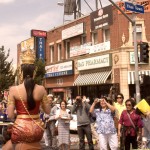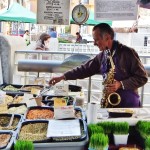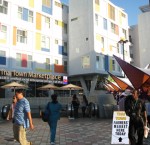Our Community
The Thai Immigrant Experience in the United States
Southern California is home to the largest Thai population outside of Thailand. Reports estimate that 100,000 Thais make their home in Southern California. The Thai community possesses a relatively recent history of immigration to the United States compared to other Asian ethnic groups with the first wave of Thai migrants arriving in the 1950’s.
While the proliferation of Thai-owned businesses and shops has converted East Hollywood and some Northeast San Fernando Valley neighborhoods into cultural destinations, the Thai community in Southern California still reverberates from the international headlines over the 1995 El Monte Thai Garment Slavey Case and the 2003 Global Horizons Thai Farmworker Case.
Thai migration has passed through three stages:
- Pioneer migration
- Group migration
- Mass migration
The first stage, pioneer migration, coincided with the two post-war decades, when only a handful of educated, middle-class Thais immigrated each year. The second stage, group migration, was ushered in by the change in American immigration laws; it was marked by a slow but steady increase in numbers and by a gradual change in the composition of the migrant flow. At the present time, the third stage or mass migration is occurring, which includes many economic immigrants seeking new opportunities. Of the three stages of Thai migration, the last stage starting from the 1980’s until present, is characterized by immigrants with lower educational attainment (only up to a third grade level of education) and an unskilled/semi skilled workforce whose lack of English language proficiency and undocumented status makes them vulnerable to the most severe and egregious forms of exploitation. It is this group that represents the target population of Thai CDC.
Because Thais are economic immigrants and are not refugees like other Southeast Asians in the United States, they are not eligible for public benefits and therefore, tend to fall through the cracks, having no resources to turn to for help when in need. Also, the recent immigrants are more economically disadvantaged compared to the immigrants who preceded them, creating an extremely bifurcated community of “haves” and “have nots.” Therefore, it is imperative for Thai CDC to eliminate this economic and social disparity and create a middle class in the community while preventing the creation of a permanent underclass.
All peoples have a basic right to a decent standard of living and quality of life. Yet, in the Thai and other disadvantaged communities, people are living in substandard housing and lack access to basic health services, education and quality employment. Since its establishment, Thai CDC has addressed the multifaceted needs of Thai immigrants.
United States:
- 17.3 million Americans are of Asian descent.
- Thais make up 237, 639 people of that number.
- 46% increase in population occurred within the Asian community in the US between 2000 – 2010.
California:
- 5.6 million Asians reside in California.
- 28.5% of Thais living in the US reside in California.
Los Angeles:
- 33% of Thais earned less than $15,000 in annual income. (The median income in LA county for a family of four is $52,300.)
- 29% percent of the Thai labor force is unskilled workers, the highest percentage in an occupation category.
- 42% of Thais do not have a high school diploma (LA country average is 16%)
East Hollywood
 With the proliferation of Thai-owned businesses and shops, East Hollywood has become a Thai ethnic enclave for newly arrived Thai immigrants, the majority of whom are poor and speak no English. A disproportionately large number of individuals in the East Hollywood area lack job skills and/or are chronically underemployed. Thai CDC will use its expertise in small business formation, economic development and business management to start up a social enterprise that will create jobs and business opportunities for low-incomes individuals. By making it easier for locally-owned and operated small businesses to start up and succeed, entrepreneurs will feel a greater sense of self-worth and confidence as they strive to turn their vision into economic realities. As part of the area’s diversity, over 60% are foreign born (Census 2000 Summary File 1 and 3). Although we consider such diversity an asset, this results in a greater need for culturally appropriate services and cross-cultural collaboration. In addition, due to the large immigrant population, rates of entrepreneurship are high.
With the proliferation of Thai-owned businesses and shops, East Hollywood has become a Thai ethnic enclave for newly arrived Thai immigrants, the majority of whom are poor and speak no English. A disproportionately large number of individuals in the East Hollywood area lack job skills and/or are chronically underemployed. Thai CDC will use its expertise in small business formation, economic development and business management to start up a social enterprise that will create jobs and business opportunities for low-incomes individuals. By making it easier for locally-owned and operated small businesses to start up and succeed, entrepreneurs will feel a greater sense of self-worth and confidence as they strive to turn their vision into economic realities. As part of the area’s diversity, over 60% are foreign born (Census 2000 Summary File 1 and 3). Although we consider such diversity an asset, this results in a greater need for culturally appropriate services and cross-cultural collaboration. In addition, due to the large immigrant population, rates of entrepreneurship are high.
Businesses of East Hollywood:
- Over 60% of businesses in East Hollywood are sole-proprietorships.
- 80% have fewer than eight employees.
- 25% have one employee.
Resident of East Hollywood (According to US Census 2000:)
- 35% live below the poverty (state average – 14%.)
- 16% are unemployed (HealthyCity.org; Bureau of Labor Statistics.)
- 13% receive public assistance (state average – 5%, national -3%
The largest population of Thais outside of Thailand reside in Southern California.
Our work:
 Creation of Thai Town In 1999, the world’s first and only Thai Town was officially designated by the Los Angeles City Council. […]
Creation of Thai Town In 1999, the world’s first and only Thai Town was officially designated by the Los Angeles City Council. […]-
 East Hollywood Certified Farmer’s Market is a new start-up market that improves access to affordable locally-grown fruits and vegetables and encourages healthy behavior among low-income and vulnerable populations in the underserved neighborhood of East Hollywood. […]
East Hollywood Certified Farmer’s Market is a new start-up market that improves access to affordable locally-grown fruits and vegetables and encourages healthy behavior among low-income and vulnerable populations in the underserved neighborhood of East Hollywood. […] Thai Town Market Place is an innovative approach to community revitalization which facilitates economic empowerment and improvement of public spaces.[…]
Thai Town Market Place is an innovative approach to community revitalization which facilitates economic empowerment and improvement of public spaces.[…]
 Thai Culture in Los Angeles Celebrating our culture while promoting our community is one of the main strategies Thai CDC employs in heritage marketing and the revitatilization of public spaces for economic develeopment […]
Thai Culture in Los Angeles Celebrating our culture while promoting our community is one of the main strategies Thai CDC employs in heritage marketing and the revitatilization of public spaces for economic develeopment […]  Small Business Development provides asset building opportunities including financial education and entrepreneurship training to low and moderate income Thais and other ethnic community members in the greater Los Angeles area. […]
Small Business Development provides asset building opportunities including financial education and entrepreneurship training to low and moderate income Thais and other ethnic community members in the greater Los Angeles area. […]
Live, Work and Play in East Hollywood Consumer Resource and Health Fair!
Thai CDC started the Consumer Resource and Health Fair in East Hollywood. This free event is the first of its kind to be held in the area. Its sole purpose is to improve the quality of life for East Hollywood residents in terms of creating opportunities for improved health, housing, jobs, and recreation. The “Live, Work & Play in East Hollywood” event makes information more accessible that is pertinent to the needs of East Hollywood individuals, families and their children for an improved quality of life. The East Hollywood community is a very diverse mix of Latin Americans, Armenians, Russians and Thais. This fair helps individuals access information that aids them in becoming wiser consumers while enjoying good health and recreation.
Residents learn about:
|
|
